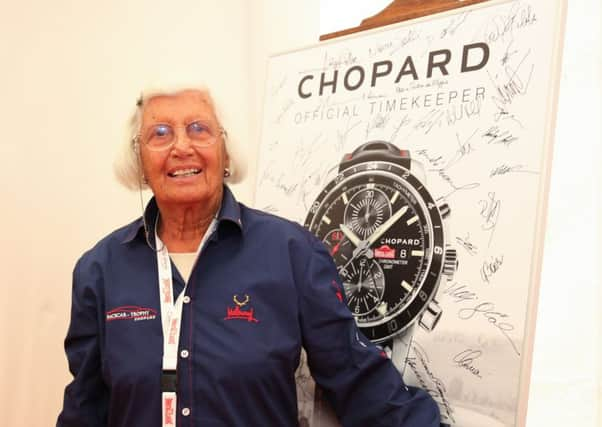Obituary: Maria Teresa de Filippis, racing driver


Maria Teresa de Filippis was a pioneer for women in sport, in particular in motor racing, becoming the first woman to compete at the highest level in a Formula 1 World Championship Grand Prix, at the same time as some of the greats of the sports, including Sir Jack Brabham, Sterling Moss and Juan Manuel Fangio.
In an era when women were still expected to be “seen but not heard” and despite having limited F1 opportunities, she had a knack for turning scepticism into surprise as she competed successfully in motorsport, despite suffering setbacks as a result of her gender.
Advertisement
Hide AdAdvertisement
Hide AdHer introduction to racing came as a result of a bet between her and her brothers over how fast she could drive, which resulted in her entering, aged 21, and winning, her first event, the Salerno-Cava dei Tirreni hill climb, in a tiny Fiat 500 in 1948.
She recalled that men were initially doubtful of her ability, although the only time she experienced true prejudice came in France when she was prevented from taking part in the 1958 French Grand Prix in Reims. Toto Roche, the race director, looked her up and down before declaring, “The only helmet a beautiful woman should wear is the one at the hairdressers.”
“Apart from that I don’t think I encountered any prejudice - only surprise at my success,” she added. Although there were “difficulties and misunderstandings” she had to overcome, she said, “Many journalists, too, did not always want general news but tried to get me to talk about particular situations as the only woman in the field.”
De Filippis walked away from the sport following the death of her team owner and great friend, French driver, Jean Behra before the 1959 German GP and retired from racing aged 23, explaining in an interview in 2006, “Too many friends had died.”
Born into a wealthy Neapolitan family in 1926, Maria Teresa de Filippis was a keen sportswoman from an early age, excelling in horse-riding, skiing and tennis. Following her successful competitive debut in the 1948 10km hill climb, she continued to practise around the Amalfi coast. Her parents never raised any objections, with her mother simply saying, “Go slow and win.”
In the 1950 Giro di Sicilia, however, she found herself surrounded by controversy following her disqualification. After the race, she had been presented with flowers for her performance in the 1080km race, only to be later disqualified for a dubious infringement on the start line. She was furious but was beginning to learn that even though she was a dark and attractive girl in white overalls and linen helmet, “there were no concessions save, perhaps, a twinge of embarrassment at her pace against the men.”
She continued racing, with a number of Top 10 finishes, and in 1954 finished second in the Italian sports car championship, which prompted Italian carmaker Maserati to hire her as a works driver. De Filippis took part in various motor racing events, including hill climbing and endurance racing, before being given the chance to drive in Formula One. By now the Italians were calling her “una diavola” (she-devil) and she was attracting plenty of admirers.
During this period she met and fell in love with fellow driver Luigi Musso, who helped to improve her driving technique. Although the couple got engaged, they never married and eventually separated. .
Advertisement
Hide AdAdvertisement
Hide AdDe Filippis’ big break came in 1958 when she entered under her name her first world championship event at Monaco. Driving one of the 250F’s, her seat was slightly redesigned with extra cushioning so that she could reach the pedals, but the slow, twisting street circuit proved too great a physical stress and, along with fellow debutant Bernie Ecclestone, driving a Connaught, failed to qualify.
Later Fangio, who became a friend, told her, “You go too fast, you take too many risks.” De Filippis took the advice on board and four weeks later qualified for the Belgian Grand Prix at the dangerous and fast circuit at Spa-Francorchamps, qualifying 19th and finishing 10th.
After watching de Filippis at one event, Denis Jenkinson, sports editor of “Motor Sport” magazine wrote, “An interesting sight at the Gran Premio Siracusa was to see a 26-year-old Italian girl driving a grand prix Maserati and not teetering round at the back of the field in an effeminate way, but having a real go.”
In 1959, de Filippis joined friend Jean Behra, who she described as “a man without fear,” at the Porsche RSK team, but failed to qualify for the Monaco Grand Prix by three seconds. With Behra’s death later that year in a race before the German GP at Avus, and the deaths of Musso, Mike Hawthorn, Alfonso de Portago, de Filippis walked away from motor racing and into retirement.
While holidaying in St Anton, Austria, de Filippis met Theodor Huschek, an Austrian textile chemist. They married a year later living in Austria and Switzerland, before moving to Italy.
In 1979, she joined the International Club of Former F1 Grand Prix Drivers, a union for F1 drivers, serving as the club’s vice-president and later becoming its honorary president. .
In later life, she was asked if she had earned much money to which she replied, “I remember receiving £500 for taking part in the Daily Express Trophy at Silverstone in 1958, but apart from that I can’t say I earned very much. My contract with Maserati split all costs and prize money50-50. But I wasn’t in it for the money; it was the thrill of racing and competing.”
De Filippis died after battling “a long and debilitating illness”. She is survived by her husband and their daughter Carola.